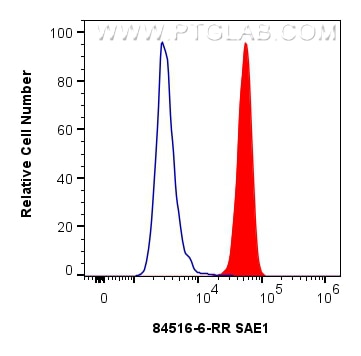Tested Applications
| Positive IF/ICC detected in | MCF-7 cells, HeLa cells |
| Positive FC (Intra) detected in | A549 cells |
Recommended dilution
| Application | Dilution |
|---|---|
| Immunofluorescence (IF)/ICC | IF/ICC : 1:250-1:1000 |
| Flow Cytometry (FC) (INTRA) | FC (INTRA) : 0.25 ug per 10^6 cells in a 100 µl suspension |
| It is recommended that this reagent should be titrated in each testing system to obtain optimal results. | |
| Sample-dependent, Check data in validation data gallery. | |
Product Information
84516-6-RR targets SAE1 in IF/ICC, FC (Intra), ELISA applications and shows reactivity with human samples.
| Tested Reactivity | human |
| Host / Isotype | Rabbit / IgG |
| Class | Recombinant |
| Type | Antibody |
| Immunogen | SAE1 fusion protein Ag0275 Predict reactive species |
| Full Name | SUMO1 activating enzyme subunit 1 |
| Calculated Molecular Weight | 38 kDa |
| GenBank Accession Number | BC000344 |
| Gene Symbol | SAE1 |
| Gene ID (NCBI) | 10055 |
| RRID | AB_3672022 |
| Conjugate | Unconjugated |
| Form | Liquid |
| Purification Method | Protein A purfication |
| UNIPROT ID | Q9UBE0 |
| Storage Buffer | PBS with 0.02% sodium azide and 50% glycerol pH 7.3. |
| Storage Conditions | Store at -20°C. Stable for one year after shipment. Aliquoting is unnecessary for -20oC storage. 20ul sizes contain 0.1% BSA. |
Background Information
SAE1(SUMO-activating enzyme subunit 1) is also named as AOS1, SUA1, UBLE1A and belongs to the ubiquitin-activating E1 family. SAE1 has a calculated molecular mass of 38 kD. SAE1 and UBA2 form a heterodimer that functions as a SUMO-activating enzyme for the sumoylation of proteins(PMID:9920803). Western blot analysis of synchronized HeLa cells detectes increased AOS1 expression as cells progressed through S phase, followed by a substantial decrease in G2 phase. Immunofluorescence analysis shows AOS1 and UBA2 distributed throughout nuclei, but they are excluded from nucleoli.(PMID:11481243).
Protocols
| Product Specific Protocols | |
|---|---|
| IF protocol for SAE1 antibody 84516-6-RR | Download protocol |
| FC protocol for SAE1 antibody 84516-6-RR | Download protocol |
| Standard Protocols | |
|---|---|
| Click here to view our Standard Protocols |









